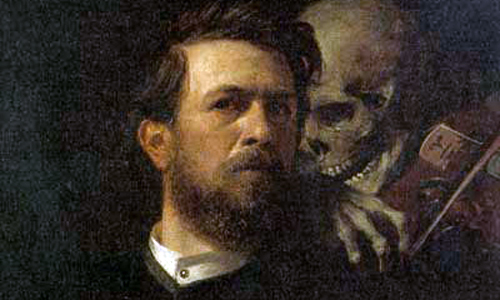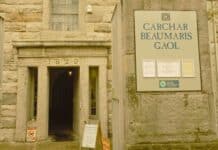The Welsh Doctor Fautus? JON KANEKO-JAMES looks at Jack O’Kent, the Welsh sorcerer supreme

History is full of dark, fated sorcerers.
We’ve all read about these geniuses who made dark pacts in order to do fantastic things, chased down and crushed by the promises they make.
Pope Sylvester II is one of them: his legend, as written by William of Malmesbury, is that he made pacts with the devil in return for great magical powers.
As his death approached he became more and more concerned with his fate, finally asking the Devil if there was a way to avoid his oncoming doom.
Ever trustworthy, the Devil counselled him to avoid ever giving mass ‘in Jerusalem’, and so the Pope immediately cancelled his upcoming pilgrimage to the Holy Land, agreeing to give a mass in the Vatican instead.
Tragically, no sooner had the pontiff started his mass than the Devil burst triumphantly into the church, strutting up the isle with a retinue of capering demons in tow.
The Devil strips him of both his life and his dignity, mutilating him in full view of the congregation by tearing out his eyes and tongue, giving them to the demons for sport.
The name of the church? San Crosse in Gerusalem.
Perhaps Sylvester is a bit obscure?
More of us know of Doctor Faustus, made famous on British shores by the playwright Christopher Marlowe.
Faustus, whose adventures were first codified by the work of German publisher Johannes Spies in the late 1580s, is a genius in many ways: he’s an accomplished lawyer; a doctor of medicine and divinity; a philosopher of great renown.
After defending the weak, revolutionising science and curing the plague he decided that he needed to a step further and gain magical powers, making a pact with the Devil.
He made a deal that he would get 24 years of service from the demon Mephistopheles (which probably felt like a very long time at the start) in return for the Devil getting full ownership of his soul after death.
Faustus’ adventures (including attracting a girlfriend, which a lot of overachieving geeks with no social skills would probably sell their souls for) see him meeting Helen of Troy, making a fool out of the Pope, impressing the royal court and crushing all who oppose him.
Unfortunately, as his time approaches its end he starts to realise the hell isn’t such an awesome place as all that after all. The story of Faustus ends on an even worse note than Sylvester’s, with him cowering in his house in Wittenburgh, praying that the Devil will inadvertently torture him enough to redeem his soul.
That’s the classical mold for the folkloric sorcerer: arrogant but good-intentioned, eventually destroyed by the fire he played with.
Then there’s Jack O’Kent.
Who Was Jack O’Kent?
Jack O’Kent is the Welsh sorcerer supreme.
Famous around the Welsh borderlands (particularly Monmouthshire and Herefordshire), he’s a magic user of a very different kind to Faustus and Sylvester.
While their magic is capable of horrible wonders, Jack’s is more the magic of the stage magician.
In the play ‘John a Kent and John a Cumber’, by the playwright and spy Anthony Munday, Jack appears much more like a stage magician than a devilish sorcerer.
His arsenal of tricks includes disguising himself as a Jesuit friar, producing magical music and strange mist.
His main interest in the whole plot (which is a fairly typical play about couples wanting to marry for love instead of money) is to harmlessly agitate the lovers while amusing himself by battling rival magician John a Cumber (who seems to be almost identical to Jack, except from Scotland.)
Even in this play, however, he seems to have real power.
When the two rustics Hugh and Turnop are talking about him, they say:
“Ile tell ye what Sir, if it be true that is spoken, marie I will not stand to it, a man were better deale with the best man in the countrey, then with Maister Iohn a Kent, he neuer goes abroad without a bushell of deuilles about him, that if one speak but an ill woord of him, he knows it by and by, and it is no more, but send out one of his deuilles, and whers the man then? Nay, God blesse me from him.”
The two countrymen then go on to lament on how Kent is uses his demons to spy on them while they’re out drinking and send word of any infidelity to their wives. Definitely a work of devilry.
And, like Faustus, he has a demonic assistant: Shrimp, who seems much more loyal to Jack than Mephistophelse.
Rather than just seeming to make Jack’s schemes happen so that he can inch towards hell, Shrimp is a full partner in the sorcerer’s mischief making.
He deforms himself to fit through a keyhole and spies on Cumber; he plays phantom music to lead the lovers to where they need to be and sings the song ‘of the bride’s loss’ to incriminate the rustics.
Even Jack’s Scottish opponent, John a Cumber, is a man of terrifying power compared to Faustus and Sylvester: in the play it is stated that he has defeated the Devil, forcing Old Nick to serve a seven year apprenticeship under him.
As to a historical Jack O Kent?
With the proviso that there probably isn’t a ‘real’ Jack O’Kent any more than there was a real Arthur, there are some historical figures who correspond with some of the different aspects of Jack O’Kent, and who share either the same name or strikingly similar ones.
Dr. Ifor Williams, of the University of Wales Bangor, collected a compendium of the main suspects in 1925.
He felt that the figure of Jack O’Kent had been woven around Dr. John Kent Caerleon, an astronomer and author of a book on Witchcraft who died in the 13th Century.
Added to the mix was Dr. John Gwent, a Welsh Franciscan and worker of miracles, and John Kent (some sort of Robin Hood figure and bandit on the Welsh borders).
John Hobson Matthews feels that Jack was cut from the cloth of Father John of Kentchurch: a Franciscan friar, bard, and Oxford Professor who lived and died in the fifteenth century.
Moreover, not only was John of Kentchurch an accomplished writer and poet, but he was a scientist of note, seemingly able to perform ‘miraculous feats’ by the knowledge of natural processes (something he had in common with the real-world Pope Sylvester II).
What Did Jack O’Kent Do?
Kent’s myths are at their most representative when he’s outwitting the Devil: he’s associated with a bridge between Kentchurvch and Grosmont in Herefordshire, the stories saying that he built it in a single night, moving rock side-by-side with the Devil, in return for the promise that the Devil could have the soul of the first passenger that crossed it.
As dawn approaches the Devil begins to get impatient, pressuring Jack to cross the bridge, knowing that once the cock crowed, he would be banished back to hell.
Thinking quickly, Jack saw a stray dog nearby and tempted it with a bone.
The starving dog was desperate for food, and so when it came bounding towards him in the expectation of a good meal he threw the bone, tricking the dog into crossing the bridge.
The Devil fumed in rage as the first cock crowed, banish him and the unfortunate pooch to hell.
Jack also seems to make a good living out of cheating the Devil.
Not only does he trick the Lord of Flies into improving Herefordshire’s infrastructure, he also regularly tricks him in business deals: in one story Jack and the devil agree to split a a drove of pigs with the Devil.
The Devil agrees to take all the ones with straight tails, our sorcerer feeds them plenty of beans and drives them though a stream, which apparently puts the requisite kink in them.
Not only that, but in another story Jack and the Devil agree to split a crop of corn, half each… so Jack claims the top half of each stalk, meaning that he gets all the grain and leaves the Devil with a crop of shafts.
In that story, the Devil decides to work smart and insists that the following year he’ll have the top halves of whatever crop is planted… so Jack plants turnips, leaving the Devil with some inedible leafy bits.
The Death of Jack O’Kent
Despite the fact that the Devil is the source of all evil, Lord of Flies, Fallen Angel, and so on… you’d be excused for thinking that Jack is giving him a bit of a hard time.
So, it’s understandable that Old Nick decides to get his own back on Jack post mortem.
The Devil tells Jack that he will have his soul whether he is buried inside or outside a church.
The Devil, after years of being fleeced, promised Jack that he would carry him off, body and soul, to Hell for legendary torments.
Jack’s answer was to be buried inside the thickness of the wall at Grosmont Church (some say it was Kentchurch Church), neither inside nor outside the church, but in a liminal space between.
Not only that, but according to local folklore there’s some proof that it seems to have worked: in Kentchurch Court there is said to be a cellar where he kept his magical horses, and a panelled room in the same house is pointed out as his bedroom.
It’s said that on stormy nights a ghostly figure walks out of the wall and plays tricks.
It’s even said that there are spikes on the top of the walls of Grossmont Chruch there are spikes where Jack’s innards and eyes were put after his death, and that a crow and a dove return eternally to battle over their spiritual remains. When one wins, his final fate will be decided…








Great little piece. Makes me want to make a film about Jack o Kent now. Has anyone else thought of that?
Sounds like a great idea Peter – who do you think would play Jack o Kent now?